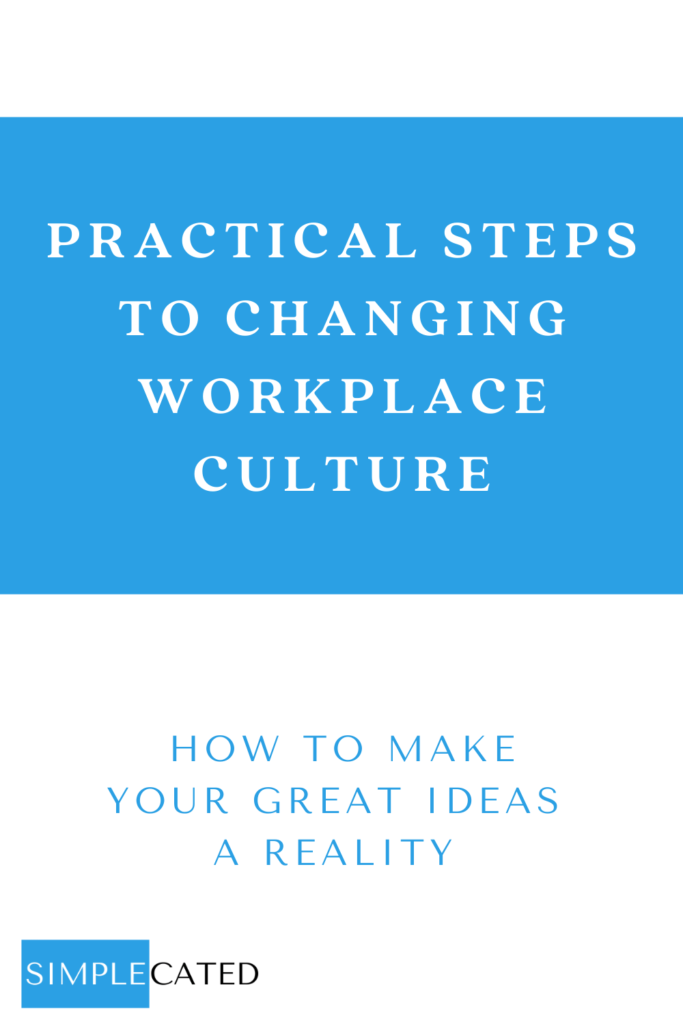The beginning of the year always feels to me like a blank slate full of promise and anticipation. The whole year stretches out ahead, and the possibilities are endless. Anything can happen!
That means this is the perfect time to think about your workplace culture. After all, as a leader, you’re responsible for the culture of your department (or maybe even the culture of the entire organization). Is it what you want it to be? What would you like to change?
The idea of changing workplace culture can seem daunting because there are so many moving parts. There are so many elements that come together to create your workplace culture. On top of that, you have varying demographics and personalities, multiple job functions, factors that may be outside of your control, and some employees who may not even like each other in the first place!
When it comes to changing workplace culture, we can have really great big ideas but find it hard to figure out how to realistically accomplish them. So, let’s get practical. Here are first steps to take in changing workplace culture that will put you on a path to creating a better, healthier, more enjoyable workplace.
Write down your ideas.
Chances are, you already have ideas of things you’d like to change, even if you generally enjoy your workplace. Write them all down. Don’t analyze just yet or try to figure out what’s doable – get them on paper. It’s easier to analyze when you can see your ideas in front of you. Now’s your chance to dream big, so take advantage of it!
Focus on what’s within your control.
When it comes to how to change workplace culture, you can only change what’s within your control. If any items on your list are outside of your control, either don’t focus on them or adjust them to fit within your control. Maybe you’d love for the IT employees to respond more promptly to issues, but you work in a different department. You could certainly talk with the IT leaders and let them know of your concerns, but how it’s handled is outside of your control. What’s within your control is how your department communicates with others and how promptly you respond to the needs of others.
Categorize based on core values.
Now that you have a list of ideas that are within your control, determine what main categories these ideas fall under. If your company has core values, then use those categories. Otherwise, categories such as respect, communication, camaraderie, and trust might help. Maybe your employees are routinely late to work and don’t seem to care about their jobs. Both of those issues could be categorized under respect. We show respect for each other when we keep our commitments to each other (a.k.a. attendance) and do our best (a.k.a. performance).
Categories help you to lump together similar concepts to determine how you can make the biggest impact. They also help you outline what you’re aiming for rather than just what you don’t want. Rather than telling your employees you want everyone to focus on not being late all the time, you can talk about making respect a bigger part of your culture.
Choose 1-2 items as a team.
You can’t change a group culture by yourself. Plus, you’re probably not the only one who hopes some of these things will change too. Involving your employees in changing workplace culture provides them a sense of ownership, allows them to have a say in items that directly affect them, and gives you the benefit of their insights.
As a team, choose 1-2 items to focus on. It may be tempting to try to do everything, however, choosing 1-2 things at a time allows you to really focus on succeeding with those changes rather than being so spread out that nothing gets completely accomplished.
Once you’ve chosen your priorities, decide how you’ll accomplish this. Be practical and realistic. Using SMART goals is a great way to make sure your goals are effective.
Model the way.
If you’re wanting your employees to be on time to work, you’ll need to set the example. If you want employees to treat each other respectfully, make sure you ask before accusing. As the leader, others will look to you to set the tone and demonstrate what’s acceptable. Whatever you hope for your culture to be, make sure you’re modeling the way.
Remember, workplace cultures are built day by day. Therefore, changing workplace culture happens at the same pace. Be patient, and stick with it. Slowly but surely, you’ll make progress in bringing positive changes to your workplace culture. Be sure to celebrate your success!
Photo credit: By cacaroot / Canva





